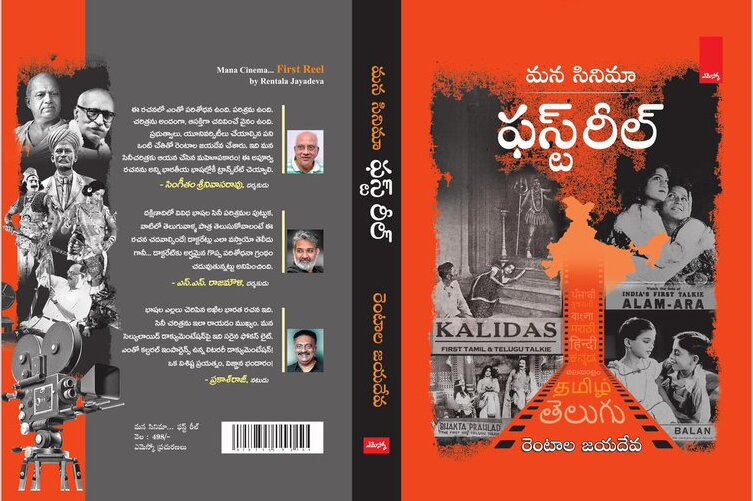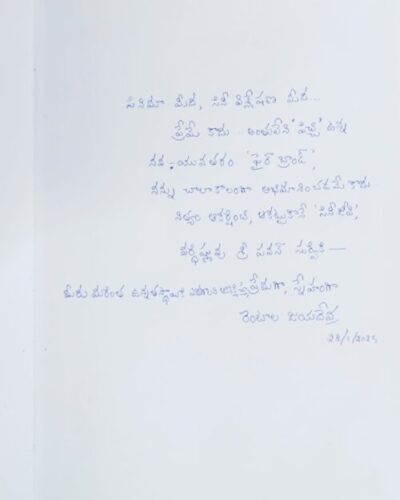Mana Cinema First Reel: An Archival Museum

This is not a movie review, but an appreciation of the Telugu book Mana Cinema: First Reel. It explores the origin of cinema and its evolution across various Indian languages. The aim of this piece is to introduce you to this jewel in the crown of Indian cinema. Let me write a few lines in Telugu before continuing with my English write-up.
“ప్రేమకు నిర్వచనం ఇవ్వగలవా?” అంటూ నన్ను ఒక స్నేహితుడు అడిగినప్పుడు, “సంతోషం ఎక్కడ దొరుకుతుందో అదే ప్రేమ” అన్నాను. ప్రేమకి సంతోషానికి సంబంధం ఏమిటి అని అతను అడగలేదు, నేను చెప్పాలి అనుకోలేదు. సంతోషం లేని చోట ప్రేమ ఉండదు… ప్రేమ లేని చోట సంతోషం నిలబడదు. ఉదాహరణ కు ఇంట్లో మనం ఉన్నట్లు బయట ఉండలేం .. మొహమాటం, తెలియని వ్యక్తి ని ఇబ్బంది పెట్టడం ఎందుకు … మనం ఇబ్బంది పడటం ఎందుకు అని చాలా ఆలోచిస్తాం. అదే ఇంటికి నచ్చని వాళ్ళు వస్తే? అదే ఇల్లు మనకి ఎర్రటి ఎండకల్ లో పొయ్యి మీద కాలుస్తున్న కండె నుంచి వచ్చే పొగ పక్కన నుంచున్నట్టు అనిపిస్తుంది. అదే బాగా నచ్చే వ్యక్తి ఎంతో కాలం తరువాత ఎక్కడో బయట కలసినా … మనలో ఉన్న కోతి పూర్వీకుడు బయటికి వచ్చేస్తాడు అదే పిల్లాడి లా ప్రవర్తిస్తాం అని కపి భావన. ఈ పుస్తకం ఆ స్నేహితుడు లా మనకి మనం ప్రేమించే సినిమా ని పరిచయం చేస్తూనే అప్పుడపుడు కండె కాల్చే పొయ్యి పక్కన కూడా నిలబెడుతుంది. ఎన్నో విషయాలు విశేషాలు తెలుసుకుంటూనే ఒక కథ కన్నా ఒక చరిత్ర ని అదే పెద్ద కథల సమాహారాన్ని చదువుతున్నాం అనే భావన మిగులుస్తుంది. అంటే ఇదొక నిఘంటువు, encyclopedia, పెద్దబాలశిక్ష అన్నమాట. మనం ఏదైనా చదవాలి అనుకుంటే అది దొరుకుతుంది … కానీ ఎప్పుడూ చదవాలి అనుకోము. అలాగే అవి అందరూ చదివి తీరాల్సిందే .
రెంటాల జయదేవ గారు భగీరథుడు గంగా ని భూలోకానికి తీసుకురావడానికి చేసిన తపస్సు లాంటిదే చేశారు … అసలు సినిమా తల్లి ని ఇవాళ మనం చూసే బొమ్మలు కొలువు తీరిన గుడి, సత్రం, రచ్చబండ, బాతాకాని కొట్టుకునే చోటు, ప్రేమికులు గిలిగింతలు – కామాకుల చీకటి ఆటలు, పిల్లల కేరింతలు అన్నిటికి మించి నచ్చిన స్టార్ల మిరుమిట్లు చూసి ఆనందబాష్పాలు, రెచ్చిన ఉత్సాహం తో వేసే గెంతులు, చేసే అల్లరి … ఇలా అన్నిటికి నిలయం ఎవరు చేశారు? ఎందుకు? ఏమిటి దీనికి ఉన్న ఆకర్షణ ఇలా ఎన్నో విషయాలు బయటికి తెచ్చి భగీరథుడు తన పూర్వీకుల కు ఉత్తమ గతులు కల్పిస్తే… మనకి జ్ఞాన అభిషేకం చేసి వారికి నిత్యనివాళి ఇచ్చేలా చేశారు. ఆయన కన్నా ఎన్నో రెట్లు చిన్నవాడిని అయిన ఆయనకి ధన్యవాదాలు చెబుతూనే ఇది మాకు ఇచ్చినందుకు శతాధిక సంవత్సరాలు ఆయన కీర్తి కేతనం ఎగురుతూ… ఆయన చేసిన తప్పసు ఎందర్లోనో స్ఫూర్తి నింపాలి అని కోరుకుంటూ… ధన్యవాదాలు గురువర్య… మీ సంకల్పం అద్భుతం… మీ సాహసం అనిర్వచనీయం… సాహో!!
Back to English after diving into Telugu seas [yes, took help from good Telugu writers to polish it].
Let me tell a short story:
A Polish magician, in the 1300s, travelled with his troupe through rough seas to the Indian coast. Exhausted and terminally malnourished, the troupe searched for places to rest and find food. No one understood their language or way of expression. In this unfamiliar land, the Polish travellers couldn’t convince anyone of what they needed. With a heavy sigh, the magician decided to use the small stage mandapam beside the temple to showcase his tricks. His performance slowly began attracting nearby villagers, who clapped heartily as the show ended after an hour. A grand old lady approached a young troupe member, a woman, and blessed her by offering an apple. She ate it immediately. The village head, who had come after hearing about the show, saw the young woman eating hungrily and instructed the villagers to feed the troupe. The Polish magician thanked him, though no one understood his words.
The head arranged a makeshift stage for their performances and provided a special rest house for them to stay. The young woman began visiting the old lady regularly. Every Sunday, the magician held shows. The troupe members were visibly happy with the villagers hospitality, and the young woman slowly started picking up the local language. Eventually, she began living at the old lady’s house. One day, a fire broke out in the village. The troupe rushed to help the locals extinguish it. The young woman, visibly shaken by the blaze, ran to the old lady seeking comfort. In broken local speech, she explained how the magician and his troupe had fled their home in search of a new one. She told her how the rough seas had brought them here after a 45-day journey. Hugging the old lady tightly, she asked never to be sent away from this “new home”. Moved by the story, the village head invited the magician to his house for the first time. Over time, they became close friends, and the young woman was adopted by the old lady. A small Polish settlement began to form around the village, eventually growing into a town of its own.
I didn’t want to elaborate on the story too much. The intent is to talk about how art can build bridges and burn down barriers. If the Lumiere Brothers could bring their invention of moving images to different shores, why couldn’t Polish people settle in India? This is the kind of thought Rentala Jayadeva garu inspired in me through his research. Each detail showcases how painstakingly he worked to find contacts, authentic information, and put it all in order for us to read. You can feel the passion that drives him, just like it drove Modern Pictures Head R. Sundaram to build his studio in Salem. A friend once told me about a moment with his father. He’d asked, “Why should we give importance to history“? The reply was: “His-story is all about our story that we ignore. Can we neglect ourselves“? At the time, he didn’t understand the meaning behind those words. But he reflected on them for years until it sank in. I remembered those lines while reading this book. Each chapter speaks to us about the kind of passion the early filmmakers had to bring this “new art form” to the people. Yes, it is an art form. Just read the short story about how a foreigner slowly settled among us. Isn’t cinema doing the same today?
When I was in the doldrums during my 2016 phase, figuring out how to express myself and not succumb to the whims of popular voices or general perception, it was Jayadeva garu who guided me. He might not remember this, but he once said, “Never lose yourself and your voice in the crowd“. It may not have felt like a big statement to him, but for someone of his stature and seniority, to ask a person from a younger generation to keep believing in his honesty, that was extraordinary. I don’t know if I should use this word, but it felt like a validation from the universe. While negativity can crumble you and push you into darkness, there’s always a ray of light that can ignite hope. His ability to encourage and inspire is reflected in the book as well.
There have been many misconceptions about Bhakta Prahlada [1932] being the first Telugu talkie, and he clears them by presenting the original date and release of Kalidas [1931], the actual first Telugu talkie feature film. This not only highlights his penchant for truth, but also leads you into fascinating stories, like how Malayalam cinema started relatively late. His appreciation for the slow emergence of cinema in that language, and the story behind Balan [1938], the first Malayalam talkie, is a must-read. You can’t miss the thrilling love story before its making. The evolution of Udaya Studios from Udaya Pictures is equally interesting [even the logo stands apart]. Kannada cinema’s growth blending popular stories and dramas into a strong industry is nothing short of spellbinding. There’s the story of Y. V. Rao, a Telugu person who made Sati Sulochana [1934] in Kannada. And you’d be surprised by Vital, the first action star, and the way popular folk dramas were captured for screenings. There’s so much to uncover about the journey of Indian cinema. Even the photographs alone could be released as a book for enthusiasts and collectors. Once again, I’ll say it, the information in this book is rare and absolutely worth referring to. It provides “material worthy of hundreds of books in one“.
Each chapter showcases how deeply he loves this craft. They say love has five predominant stages – admiration, involvement, understanding, the less-trodden path, and addiction. His chapters reflect all five, each one layered with purpose. He begins with admiration for the Lumiere Brothers and their discovery, then gets involved with their journey, the journey of cinema itself. Gradually, he deconstructs cinema’s arrival in India, understanding the attraction it held for people, and how many greats chose that less-trodden path to explore. Finally, like those passionate forefathers, he too became addicted. As I mentioned in the Telugu portion, he became Bhagiratha seeking a path to find the Knowledge Ganga that would give those forefathers the recognition they deserve. It’s his tribute to them, for giving him his addiction: cinema – to learn from, play with, explore, and engage.
Dinosaurs might never have wondered who would follow them, but nature found a way to preserve their remains for the future to study and understand. In fact, while exploring dino bones, scientists developed techniques to decode complex DNA. If someone reads this book and understands the passion that drove these pioneering individuals to build the Empire of Cinema in India, perhaps one day we’ll see a world where film is appreciated not dismissed as mere layman’s entertainment.
In the story, a Polish magician had to perform for laymen to communicate. Cinema is much the same a medium to entertain, to communicate, and to have a one-on-one dialogue with thousands at once. Rentala Jayadeva, slightly departing from his storyteller’s style, compiled this piece of history to honour those who laid the foundation. No building stays strong without a foundation. If there ever were such a thing, it could crumble like Tripurasura’s flying cities. But the knowledge structures within us, once they settle in our brain chambers don’t get destroyed.

This special note turned this book into a life-long memory.
Recent Comments